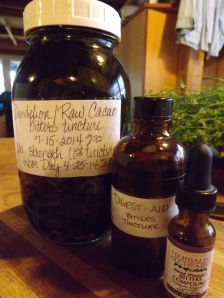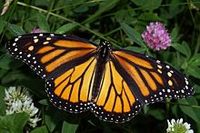A variety of Herbal Bitters
This week’s Wednesday’s Weeds is a little different. It is not about just one specific plant, but rather a class of plants often referred to by herbalists as Bitters. As their name implies they are characterized by a bitter flavor. Although the word and taste of bitter is something most people shun we actually consume many bitter plants already in the form of coffee, chocolate, and various leafy greens. Some people have a higher tolerance for this flavor. I, for example, thoroughly enjoy a strong cup of tea (a decoction) containing Dandelion, Yellowdock, and Burdock roots unsweetened. One mug is enough to perk me up, lift my spirits, and put a spring back in my step.
While the taste of something sweet slows our digestion, bitter stimulates it. Bitter plants need only be consumed in small quantities in order to be effective. They inhibit the growth of microbes, enhance immunity, protect against oxidation, and reduce inflammation as well as improving digestion. There is actually a beneficial reflex that occurs when the bitter receptors on our tongues are stimulated that tones our whole digestive tract. Stimulated regularly, this “bitter reflex” strengthens the structure and function of all digestive organs: liver, stomach, gall bladder, pancreas, and intestines.
Taking herbal bitters before a meal is a tradition of long-standing in many cultures. Doing so within 15-30 minutes before a meal stimulates the stomach to release gastrin, a hormone, and gives your body a wake up call to be ready to begin the process of digestion soon. There is a whole cascade of events that take place throughout the body once the bitter receptors on your tongue are stimulated and it is quite fascinating to read about if you are so inclined. Since low stomach acidity is often associated with allergies and immune-mediated disorders, things like allergies, asthma, eczema, or arthritis may improve with the regular use of bitter herbs.
Left to right: Cacao nibs, Dandelion leaves, and Dandelion roots
There are a variety of bitter herbs that have been used traditionally all around the world. They include, but are not limited to:
Angelica
Chamomile
Chicory
Dandelion
Gentian
Goldenseal
Horehound
Milk Thistle
Rhubarb
Rue
Wormwood
Yarrow
Yellowdock
Some, such as Goldenseal, are in danger of extinction and thus should be avoided for this purpose and reserved for situations when there is no better alternative herb. I have made a variety of herbal bitters over the years and all have proven effective. It is simple to make a bitter tincture simply by covering a variety of bitter herbs with 100 proof vodka and allowing it to steep (capped) for at least 4 weeks. Fill a jar at least half full with your chosen herbs then fill to the top with alcohol of choice, cap, label and date…and wait. You may shake it several times a day if you like but it is not essential. Once it is ready simply strain the plant material through cheesecloth, squeezing out as much as possible before composting the spent plant parts. Bottle and label your bitters and keep them in a handy spot for use before meals. I like to keep a 2 oz. or larger dropper bottle on my spice rack above the sink because it helps me to remember to take a dropper full while I am preparing a meal.
Two simple ingredients for homemade bitters: Dandelion and Cacao
Taking bitters before meals is preventive medicine at its finest. Did you know that an aperitif served during the cocktail hour before a meal contained bitters and was served for the purpose of stimulating appetite and improving digestion? A digestif would have been served after a meal and could be as simple as a cup of Peppermint tea or Coffee with a touch of Orange.
You can find Herbal Bitters from a variety of sources including Avena Botanicals, Urban Moonshine, Mountain Rose Herbs, and Herb Pharm online, as well as from your’s truly. In addition to Digest-Aid Bitters and Chocolate Dandelion Bitters, I also make an Herban Iron Syrup that is full of bitter herbs as well as mineral rich ones. But you can also make your own like the one above using two simple ingredients. This recipe came from Mountain Rose Herbs and it already smells heavenly like a chocolate-y treat. I can’t wait to start using it and I am sure I won’t ever forget to take these bitters before meals!
To make your own Chocolate Dandelion Bitters simply dig several (3-5) large Dandelion roots including the green tops. Scrub them well and chop them all up. Mix half and half with Cacao nibs or, in a pinch, you could use dark cocoa powder, combine and place in a jar, filling at least half to three quarters full. Cover with alcohol (80-100 proof), label and allow to steep for at least 4 weeks. Once it is ready strain out and compost the plant material and your bitters are ready to use. You can use a dropper bottle but it is not essential. Any bottle will do. One quarter to one half teaspoon is enough to be effective before meals. It can be taken directly on the tongue or added to a little water. Even if you stir it into juice or an aperitif the receptors on your tongue will pick up the bitterness. You can take the bitter principle a step further by adding a variety of bitter greens to your meals. Dandelion greens, Arugula, Watercress, Radicchio, and Endive are all excellent choices. Combine them with milder green like lettuces and dress with a tasty vinaigrette.
If your summer meals have seen a few too many heavy bar-b-ques and starchy and fat-drenched salads, herbal bitters may be just what the doctor ordered for a jump-start on improved digestion.
Bon appetit! ~Leenie























